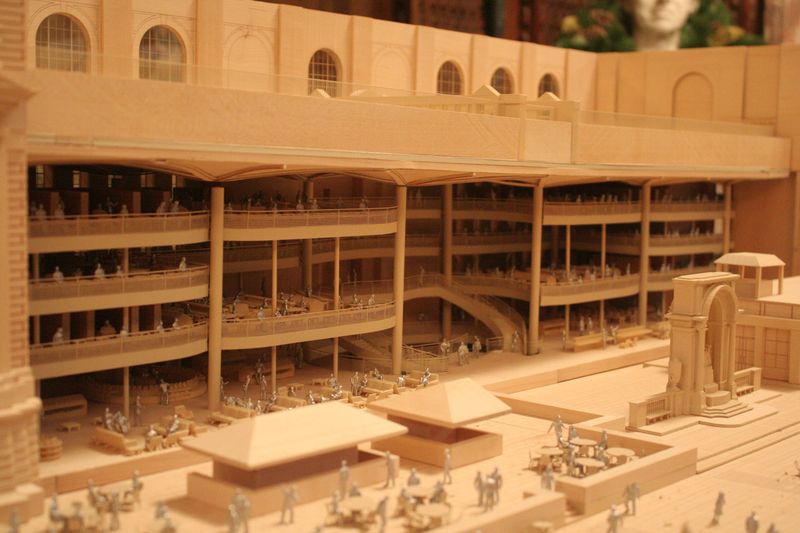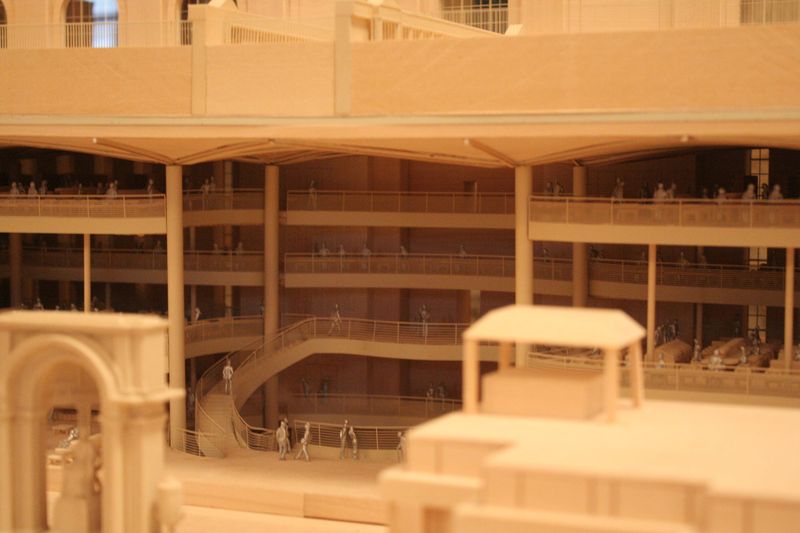This morning, I attended a press event at the New York Public Library for the unveiling of Norman Foster’s architectural plans. The library administrators’ proposal to replace the bookshelves of the 42nd Street research branch with a new circulating library has been controversial, and I was curious to know what the proposed renovation actually looked like. I’m still mulling over my impressions, but I want to convey two things, quickly (and to post my photos of the architectural model, which doesn’t seem to be available on the library’s website).
The first is that I am deeply grateful to the administrators and trustees of the library for agreeing to double the library’s storage capacity under Bryant Park. Library trustee Abby Milstein and her husband Howard Milstein gave $8 million to the library in September, for the purpose of outfitting the second, currently unused level of the Bryant Park Stack Extension, soon to be renamed in the Milsteins’ honor. The library administrators’ original plans called for a reduction of onsite book storage from 4.5 million to 1.5 million volumes, but thanks to the Milsteins’ gift, the reduction will only be to 3 million. I appreciate the generosity of the Milsteins and the flexibility of the library’s trustees and administrators.
The second is that I remain a skeptic of the proposed renovation nonetheless (though out of a recognition of personal limits, probably a less vocal one than I was last spring). Books used to arrive in the Rose Reading Room via an elevator under the delivery desk in the center of the room. Squinting at the architectural model this morning, I saw that the space under the delivery desk is now empty, so during the question-and-answer period, I asked how books would arrive under the new plan. There’s currently a conveyor belt that brings books from the Bryant Park Stack Extension into the library building, and in reply to my question, Marx said that a second conveyor belt would be added to it, and a new elevator built somewhere on the south end of the building. The architectural historian Charles Warren followed up my question with a few others: Would the new elevator be put where the Art and Architecture reading room is now located? No, it was to be to one side, probably in the southeast corner of the Rose room. How would books get from the southeast corner of the Rose to the delivery desk? There might be room to build yet another conveyor belt in the crawl space between the floor of the Rose Reading Room and the drop ceiling of the new circulating library. Was this crawl space large enough for a person to walk in it? No. Then how would the conveyor be repaired if it broke?
Marx and Foster assured Warren that they would be able to come up with an answer, and I have no doubt that they can and will. But it seemed telling that getting the books into the reading room was an afterthought, a detail not yet worked through. In Carrère and Hastings’s original plans for the 42nd Street building, the concern was central. The whole structure was designed around it. I look forward to reading what others, especially architecture critics, make of Foster’s plans.




After the new San Francisco public library was built several years ago someone – I wish I could remember who – remarked "The person who designed this library obviously hates books." There are huge open atriums and lots of meeting rooms and "community spaces."
I got the same sense looking at that model. Yes, perhaps it is a nice community space, but isn't a library about providing access to books? Shouldn't everything else be secondary. I assume the books are there, somewhere, back along the wall or something. Very sad.
It's interesting that the library's administrators are attempting to turn the library into something it is not; a community center. It is well documented that the branches of the NYPL are the community hubs and the main branch is something far special. Use the money they want to spent destroying the main branch to keep the branches opened longer, clean up some of the gems found out among them and leave the central jewel alone. Yet, the administrators, large egocentric driven donors, and government officials don't seem to give a shit. The want to use the recession as an excuse to disfigure an institution, guess what donations are down for almost all non profits since 2008, and we mustn't let this group of yahoos get away with it. Further is the historical structure that is being completely destroyed. The pneumatic tube system which was quietly put out of use this year, after 100 years of operation is completely being overlooked. If the library and the stacks are to be saved, then tubes that were used for over 100 years, will have to be saved with it. If these people get away with there plans it will be looked back upon like this centuries Madison Square Garden. Are we really going to let that happen again?
Mr. Crain (if I may),
It's pretty obvious you refuse to grasp this nation was born out of a revolution against the monarchy which started from the beginning as GRASSROOTS. If most American historians enshrined the American Revolution as if it's something to not critique they were dead wrong. However your inspiration for the hyper focusing of only the bad dynamicals of the American Revolution period is a bit convoluted and lacks the counter assessments of the most biased American historians.
I'm not here to debate you as I'm here to let you know as a young vibrant American (I'm 18) you have failed to create the perception of the American Revolution that people my age have come to know like past generations. In other words your agenda isn't working on American history. So tell me in 2013 "the agenda" in the American history realm hasn't seen the day of light does this put you in a frustrated state of mind? (And yes I know you know which "agenda" I'm talking about)
Jordan: I think you're talking about my article about the Boston Tea Party. And if so, you're right: I meant to throw doubt on the idea that it was purely a grassroots affair. Thanks for the comment.